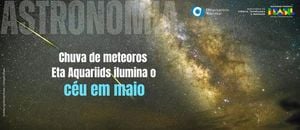NASA's James Webb Space Telescope has been capturing stunning images of the universe throughout 2024, showcasing its power and capabilities as it explores the cosmos. Known for its remarkable sensitivity and resolution, Webb's imagery offers breathtaking details and insights about distant galaxies and celestial phenomena.
This year, we’ve seen Webb capture images like the somber and swirling forms of the NGC 628 spiral galaxy. Located 32 million light-years away, this mesmerizing galaxy, found in the constellation Pisces, reveals blue, hazy regions, which signal densely packed older stars moving alongside cosmic gas and dust. Its outer filaments whirl impressively, invoking thoughts of the nautilus shell from Earth.
But the James Webb isn't just about making pretty pictures—its sophisticated instruments are paving the way for groundbreaking discoveries. Earlier this year, researchers highlighted Webb's capability to probe deep space for signs of potential life on far-off planets. With this advanced technology, scientists are hopeful they can answer the age-old question: is there life beyond Earth?
One of the telescope’s standout features is its Mid-Infrared Instrument (MIRI), which took new images of the renowned Sombrero galaxy, or Messier 104, reinforcing its place among the cosmos. Situated about 30 million light-years from our planet, the Sombrero galaxy features a dynamic center dominated by a supermassive black hole, which emits light and actively consumes matter. This galaxy uniquely hosts around 2,000 globular clusters—groups of hundreds of thousands of stars bound together by gravity.
NASA’s exploration of the Sombrero galaxy unfolded stunning revelations this year as researchers examined its outer rings. Webb's advanced perspective provided insights about how dust—an integral building block for stars and planets—is distributed across the galaxy. The rich details captured this year compare significantly to earlier images captured by the Spitzer Space Telescope, illustrating Webb's advancements over its predecessors.
Quickly following this, Webb also turned its attention to various celestial bodies and events across the universe. Significantly, its advance allowed scientists to study the forces at play within the starburst galaxy M82. The sharp images revealed polycyclic aromatic hydrocarbons, appearing as red filaments, which indicates fluctuation temperatures within M82's center—a key factor driving star formation therein.
Throughout the year, the James Webb Telescope has also been pivotal for astronomers studying the Crab Nebula. Combining infrared data from Webb with X-ray measurements from the Chandra X-ray Observatory produced illuminating images of this turbulent nebula—a remnant of a supernova explosion, which was witnessed by astronomers over 1,000 years ago. The Crab Nebula serves as a fascinating example of stellar evolution and the fantastic dynamics within nebulae.
Another highlight from 2024 was Webb's depiction of the Serpens Nebula, aptly named for its ability to showcase the birth of stars. This image featured jets of gas bursting from newborn stars, demonstrating the fundamental nature of star formation and the behavior of these cosmic bodies. Klaus Pontoppidan, principal investigator at JPL, commented on the importance of this observation, stating, "These aligned, elongated structures are a historical record of the fundamental way stars are born."
NASA used its advanced instrumentation to revisit the iconic Pillars of Creation within the Eagle Nebula, leading to spectacular enhancements of this famous image first taken by Hubble. The joint efforts of Webb and the Chandra X-ray Observatory provided astronomers with unprecedented clarity of this star-forming region, deepening our appreciation for the beauty and complexity of the universe.
Finally, one of the most intriguing images released in October showed two galaxies—IC 2163 and NGC 2207—colliding or perhaps passing each other. The unique “spooky eyes” appearance of the overlapping galaxies captures the imagination, hinting at the dynamic nature of the universe.
According to NASA scientists, these galaxies are brimming with activity, generating around two dozen Sun-sized stars per Earth year, contrasting sharply with the Milky Way's modest output of two to three stars annually. The blending of data from both Hubble and Webb pervades the final images, emphasizing the irreplaceable role of each telescope and their contribution to scientific endeavors.
With such spectacular imagery and insightful discoveries, 2024 has proven to be another monumental year for the James Webb Space Telescope. More than just awe-inspiring photos, the observatory continues to unravel the mysteries of existence, providing glimpses of how stars form, live, and die, alongside potential clues about life beyond our own planet. For more breathtaking images from Webb, visit NASA’s website to explore this year’s collection.



